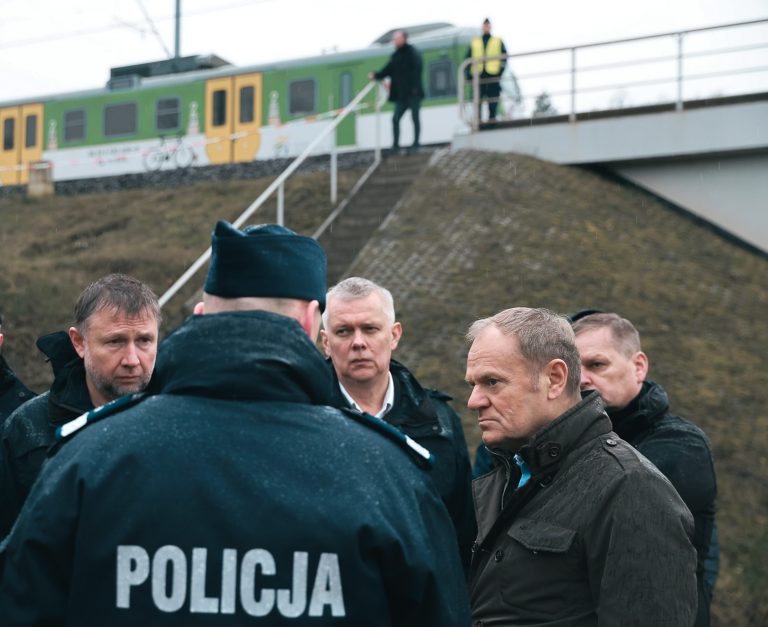On 16 November, one of the regional directorates of the police force in the eastern Polish province of Mazovia wrote on social media that about 70 kilometres from Warsaw, between the villages of Życzyn and Mika in the Garwolin district, a train driver reported a damaged track.
However, according to local residents, the explosion still occurred on 15 November at around 9pm. The site is less than 200 metres from the houses. On the same route, more than 30 kilometres from the aforementioned villages, near the town of Puławy, train drivers discovered damage to the line on 16 November. There, miscreants had tried to derail a train using metal mounted on the track.
"The rumble was terrible. My daughter, who lives near the station, said the whole house trembled. One called to another, nobody knew anything. Everyone probably thought it was some drones again. There is also a military unit nearby, where there are aviation fuel depots," a local resident told the Polish news agency PAP.
The hijackers detonated part of the track during the train's passage using a military C4 explosive. The blast did not cause the derailment, but damaged the carriage. Part of the charge remained unexploded. According to investigators, only the attackers' error prevented the casualties.
Government on alert
In the early evening of November 17, Polish Prime Minister Donald Tusk (Civic Platform) confirmed that he had contacted the interior minister in connection with the Lublin-Warsaw incident. At the same time, he did not rule out the possibility of a cover-up as the investigation was still ongoing.
"Relevant forces, including police officers, were immediately dispatched to the scene. A preliminary inspection revealed damage to part of the railway superstructure, which caused the train to stop. Railway traffic is running on the adjacent track," wrote the Radom regional directorate.
A day later, the Prime Minister said directly from the scene that the investigation had confirmed the activities of the miscreants. "The explosion of an explosive device destroyed the railway track. Rescue forces and the prosecutor's office are working at the site. On the same route, closer to Lublin, damage has also been detected," Tusk specified, adding that the miscreants would certainly be caught.
We know the identity
On the morning of November 18, an extraordinary meeting of the government's National Security Committee was held with the participation of military commanders, heads of the security services and the president's deputy. Tusk informed the Sejm shortly after 1 p.m. that the saboteurs were two Ukrainians who had long cooperated with the Russian secret services and one of whom had previously been convicted in Ukraine.
The suspects fled to Belarus, from where they came to Poland in the autumn. "The services and the prosecutor's office have all the data on these persons and captured their likenesses," the prime minister informed. One suspect is from the Donbas region and the other was previously convicted by a court in Lviv for acts of sabotage against Ukraine.
Tusk described the situation as the most serious security incident since the invasion of Ukraine and warned that Russia was trying to create chaos, panic and a rise in anti-Ukrainian sentiment.
He warned that Russia was using the same model of operations based on the recruitment of foreigners across Europe. "Russia rarely directly reveals its intentions by involving its own citizens in such actions," the Polish prime minister said.
The Polish prosecutor's office has opened an investigation into terrorist acts against railway infrastructure committed for the benefit of foreign intelligence. NATO Secretary General Mark Rutte announced that the alliance is in contact with the Polish authorities and is awaiting the results of the investigation.
Jacek Dobrzynski, a spokesman for the minister for the coordination of special services, described the incident as "almost an act of terrorism" initiated by Russia.
Dobrzynski stressed on 18 November, before the findings of the investigators were presented to the National Security Committee, that Moscow's aim was to destabilise Poland and cause fear among the population. "Everything indicates that this, one can say, almost terrorist attack, was initiated by intelligence services from the east," he said.
He added that the Russian services want to cause division in society and intimidate the population, and warned that some of the unverified information spread by the media may be part of a Russian disinformation campaign.
A pre-war state?
The Chief of the General Staff of the Polish Army, General Wieslaw Kukula, said that Poland is exposed to a hybrid war. According to him, countries always live in a pre-war state and "everything depends on our attitude, on whether we succeed in deterring the enemy or, on the contrary, in encouraging him to aggression".
Moscow, he said, is testing what it can afford and is awaiting the reactions of Polish society, the government, and the North Atlantic Alliance as a whole. Recall that late last year Warsaw approved a project to build a defensive line on the border with Russia and Belarus.
The focus is on the vulnerable Suwałki Corridor, which we have already addressed in the Standard. However, a number of experts criticise the government for the way the defence line is being built, and observers from war-torn Ukraine describe the practices of Eastern European armies as outdated.
Bulgarian investigative journalist Christo Grozev recalled that the line runs all the way to Rzeszów on the border with Ukraine and is a key artery in the supply of arms to Kiev. "It appears to have been a long-distance launch using a long (300-metre) electric cable that leads to a nearby parking lot," Grozev writes.
Slovak Defence Minister Robert Kaliňák (Smer) also told the Standard in October that the arms shipments were going through Poland, where he said US Tomahawk missiles would be delivered to Ukraine if approved by the US.
